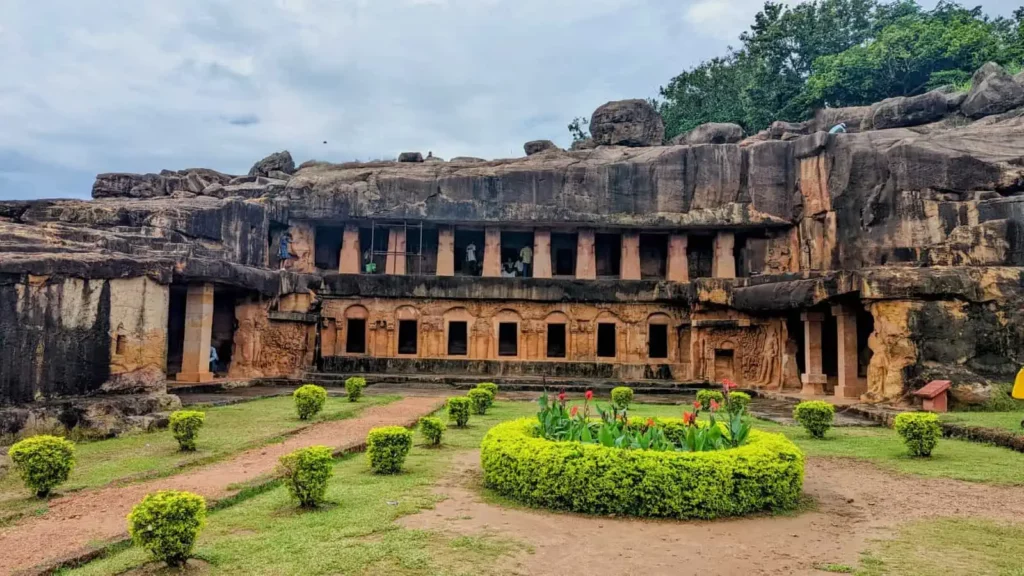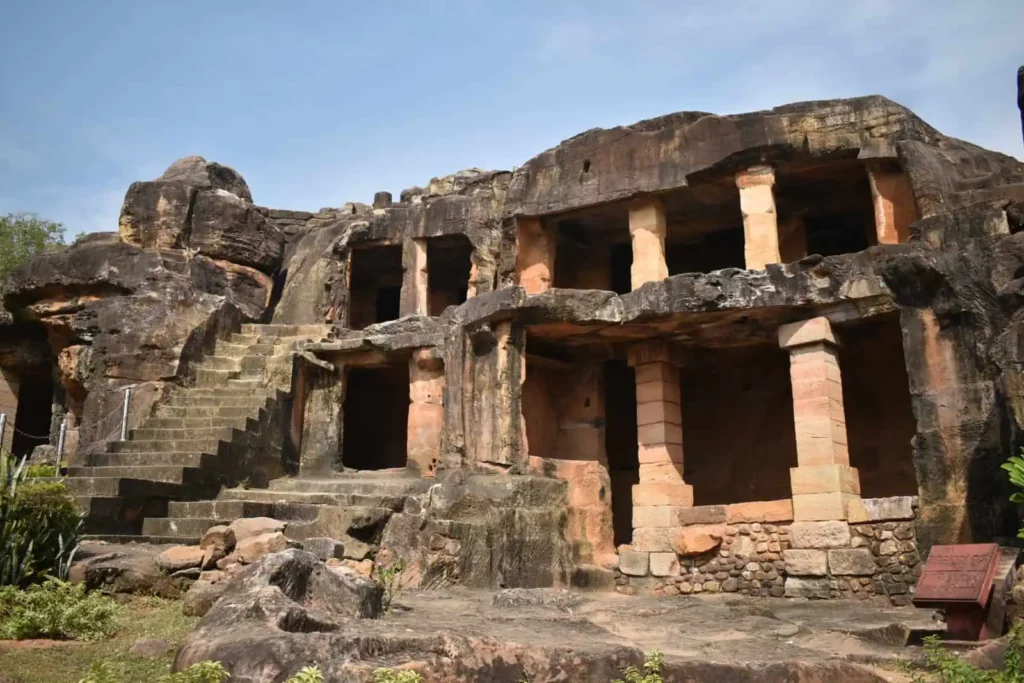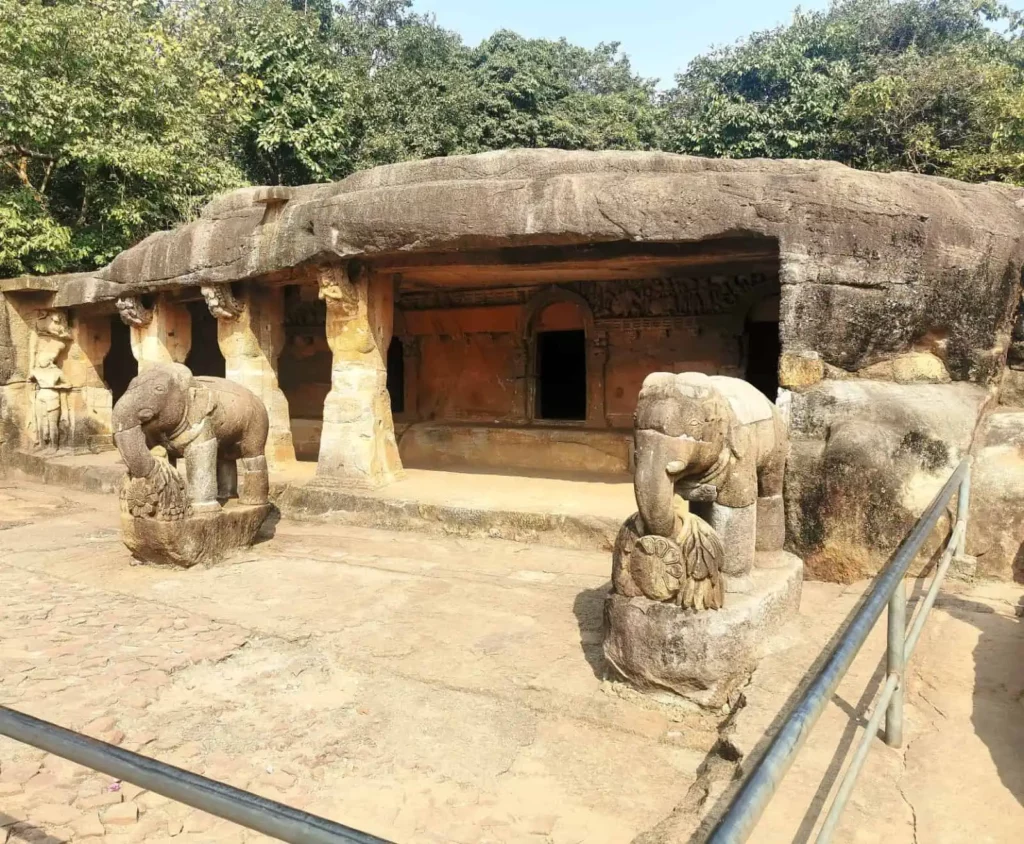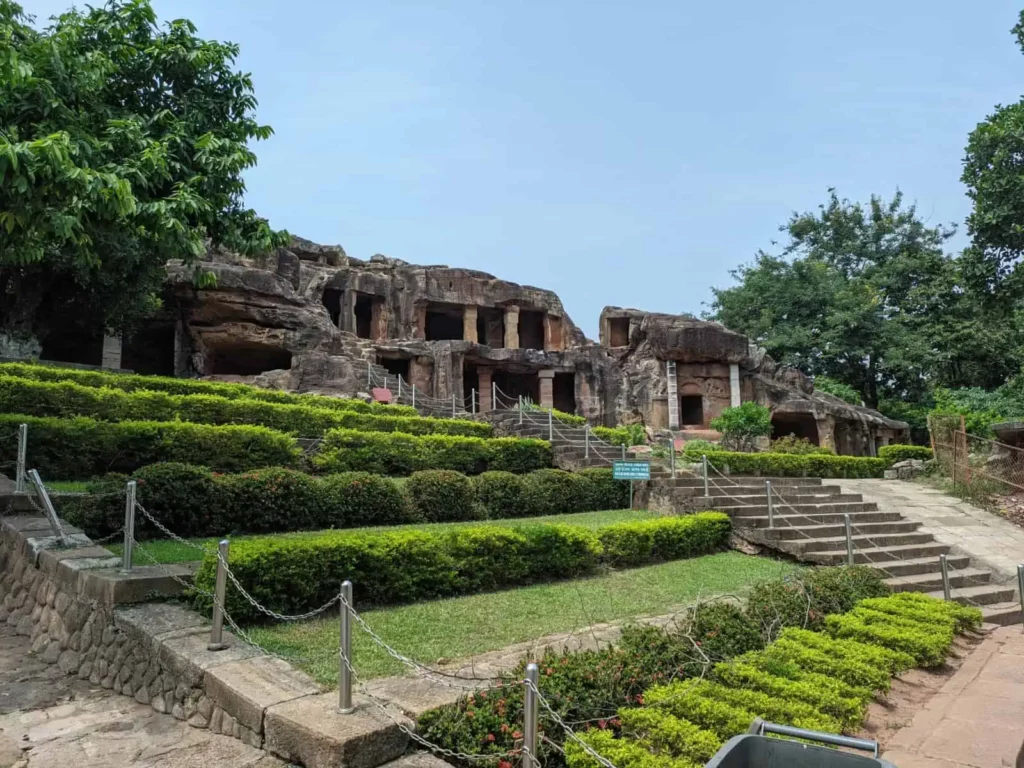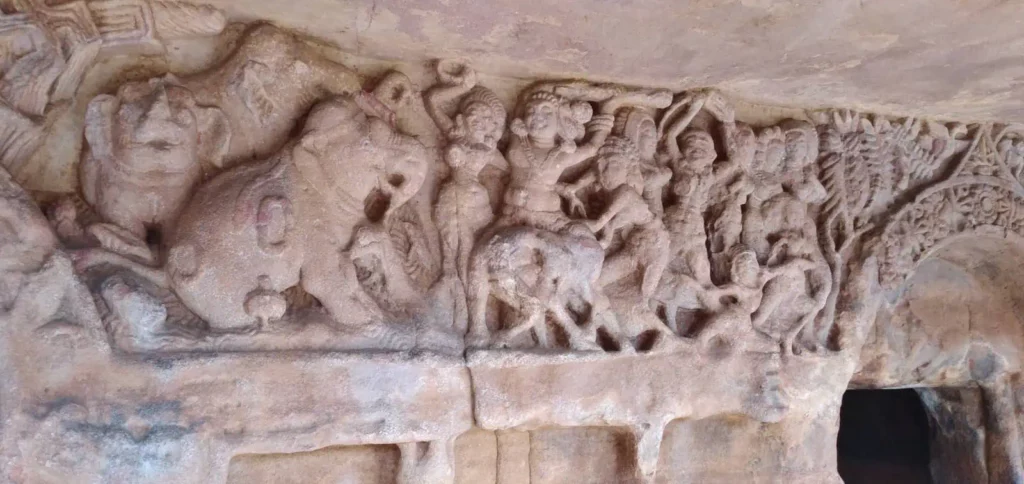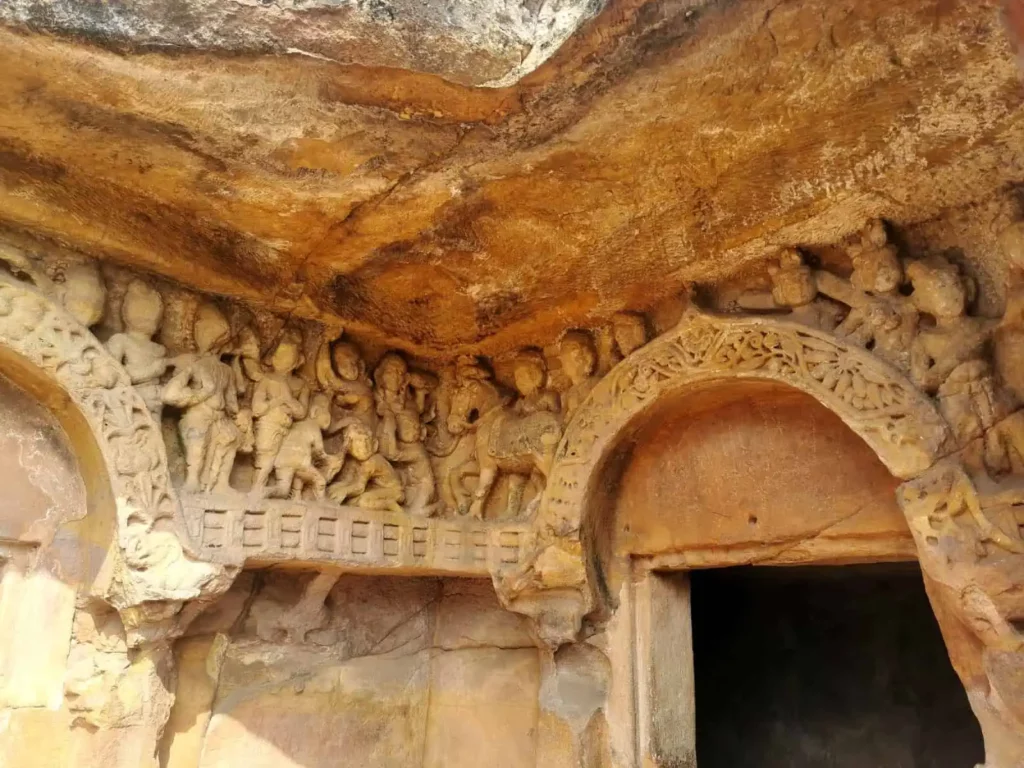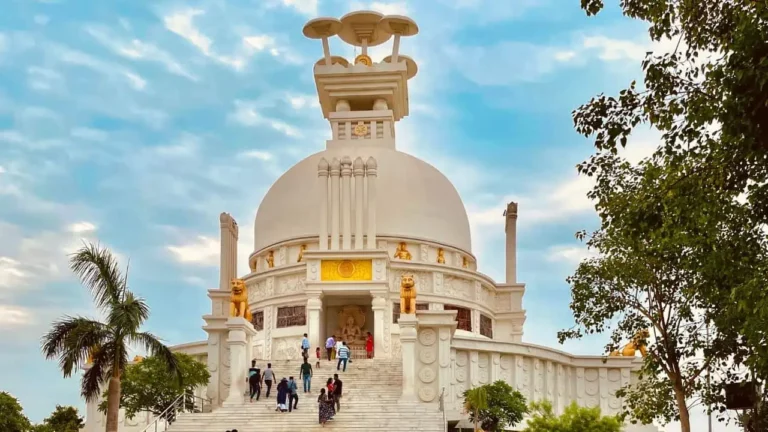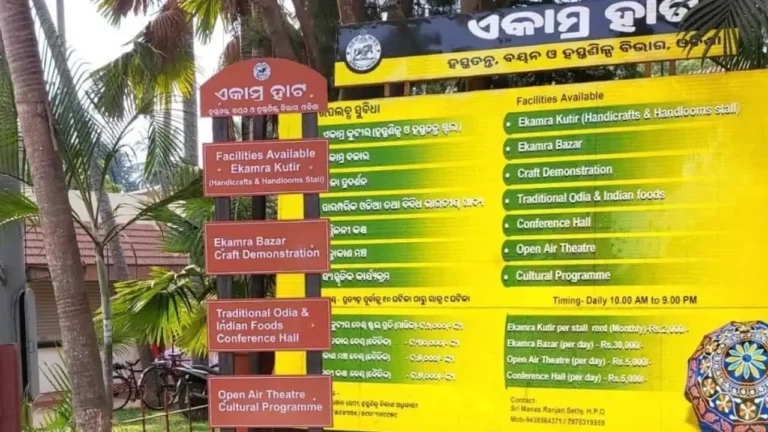Udayagiri and Khandagiri Caves: Timings, Entry Fee, History, Built by, Architecture, Location, Images
The Udayagiri and Khandagiri caves, located near Bhubaneswar, are a testament to the architectural and artistic skills of the ancient Kalinga kingdom. Built by King Kharavela in the 1st century BCE, these caves are an important part of India’s cultural heritage and attract a large number of tourists from all over the world.
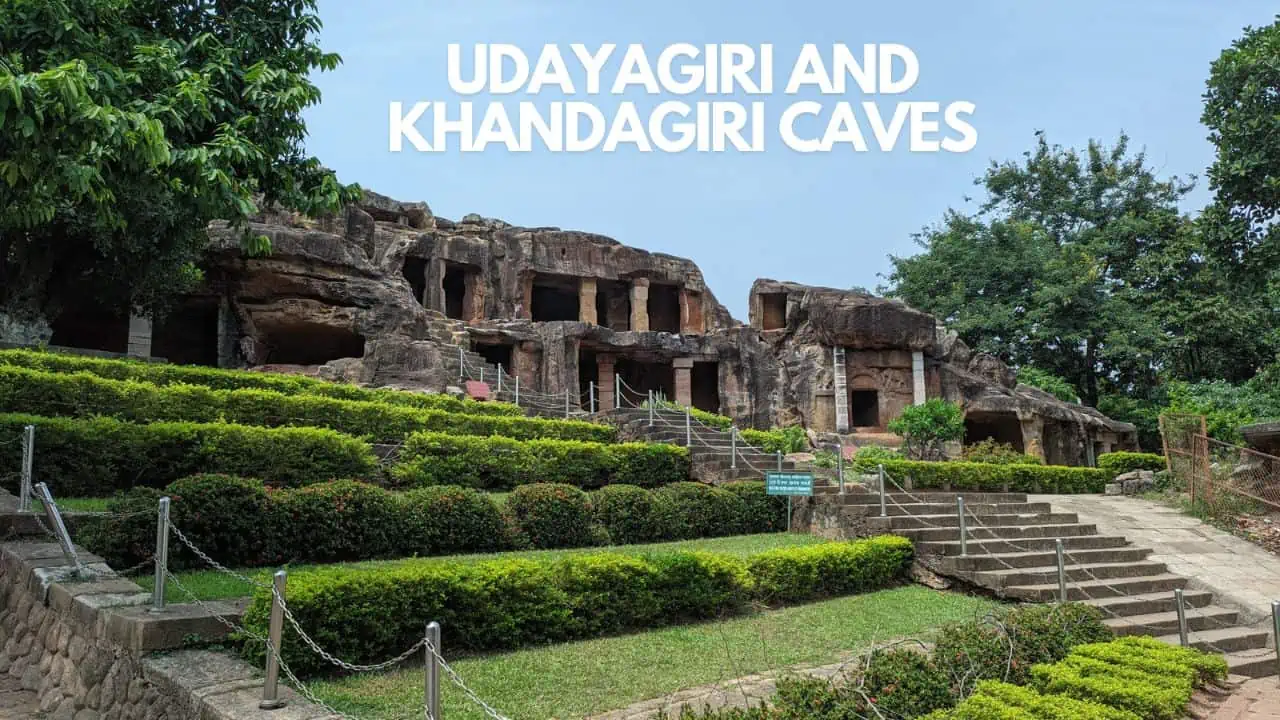
In this article, we will explore the history, architecture, and significance of the Udayagiri and Khandagiri caves.
Visiting Bhubaneswar? Consider visiting: The best places to visit in Bhubaneswar
Udayagiri and Khandagiri Caves Timings
| Day | Timing |
|---|---|
| Monday | 8:00 am – 5:00 pm |
| Tuesday | 8:00 am – 5:00 pm |
| Wednesday | 8:00 am – 5:00 pm |
| Thursday | 8:00 am – 5:00 pm |
| Friday | 8:00 am – 5:00 pm |
| Saturday | 8:00 am – 5:00 pm |
| Sunday | 8:00 am – 5:00 pm |
Udayagiri and Khandagiri Caves Entry Fee
| Type of Fee | Cost (in INR) |
|---|---|
| Indian Tourists | 15 |
| Foreign Tourists | 200 |
| Video Camera Charge | 25 |
Udayagiri and Khandagiri Caves Address and Contact Number
| Information | Details |
|---|---|
| Address | Khandagiri-Chandaka Rd, Khandagiri, Bhubaneswar, Odisha, 751030 |
| Google map Location | Click here |
| Contact Number | 0674 243 2177 |
Udayagiri and Khandagiri Caves: Images and Photos
History of Udayagiri and Khandagiri Caves
The Udayagiri and Khandagiri Caves, nestled in modern-day Odisha, are enduring symbols of the Kalinga dynasty’s rich legacy, which flourished from the 3rd century BC to the 16th century AD. These caves, primarily serving as abodes for Jain monks from the 1st century BC to the 10th century AD, stand as testaments to the era’s architectural and cultural advancements.
Key Historical Insights:
- Built During Kalinga Dynasty’s Reign: The caves were constructed under the auspices of this influential dynasty, known for its significant role in shaping the region’s history.
- King Kharavela’s Patronage: The caves’ creation is attributed to King Kharavela, a prominent and revered ruler of the Kalinga dynasty. His reign is marked by numerous military, cultural, and religious achievements.
- A Staunch Jainism Proponent: King Kharavela’s dedication to Jainism is evident in his patronage of various Jain monuments in Odisha, including the architectural marvels of the Udayagiri and Khandagiri caves.
These caves not only represent the zenith of the Kalinga dynasty’s architectural prowess but also reflect the religious and cultural ethos of the era. As such, they offer an invaluable glimpse into the historical and spiritual landscape of ancient India.
Consider reading: Lingaraj Temple Bhubaneswar History, Architecture, Timings, Entry Fee, Prasad And Photos
Architecture of Udayagiri and Khandagiri Caves
The Udayagiri and Khandagiri Caves stand as a monumental testament to ancient India’s remarkable rock-cut architecture and rich cultural heritage. Located on a 135-foot high hill, these caves encompass 18 in Udayagiri and 15 in Khandagiri, totaling 33 distinct caves. Each cave boasts unique characteristics, showcasing the exceptional artistry of craftsmen from the 2nd century BCE.
Noteworthy Features of the Caves:
- The Tatowa Gumpha (Caves 1 and 2 on Udayagiri hill) captivate visitors with their entrance adorned by Dwara palas, alongside motifs of lions, bulls, and parrots.
- Caves 3 to 6, including Ananta Gumpha and Dhyana Gumpha, further highlight the intricate carvings.
- Navamuni Gumpha (Cave 7), crafted during the 11th century Somavamshi Dynasty, displays exquisite sculptures of Sasana Devis and Jain Tirthankaras.
- Bharabhuji Gumpha (Cave 8), renowned for its depiction of 25 Jain Tirthankaras.
- Ekadashi Gumpha (Cave 14), distinguished by serpent carvings and interior decorations featuring athletes and various animals.
The Rani Gumpha in Udayagiri is a striking two-story structure, famed for its elaborate animal and musical scenes. Similarly, the Khandagiri Caves, with their rich depictions in Caves 1, 2, and 14, mirror the artistic excellence of Udayagiri.
These caves not only reflect the architectural prowess but also the spiritual depth of the era, having served as residences and meditation sites for Jain monks. Their historical and cultural significance makes them a must-visit destination, offering a glimpse into the artistic and architectural genius of ancient India.
Looking for what to see in Bhubaneswar? Consider visiting: Nandan Kanan Zoological Park
Significance of Udayagiri and Khandagiri Caves
Located in Bhubaneswar, the Udayagiri and Khandagiri Caves stand as majestic symbols of India’s rich historical tapestry. Carved into the hillsides, these caves date back to the 2nd century BCE and were primarily used by Jain monks for residential, meditation, and religious purposes.
Udayagiri, “Hill of Sunrise,” and Khandagiri, “Broken Hill,” are not just geographical landmarks but also historical repositories, bearing witness to the rise and fall of significant empires like the Mauryan, Kalinga, and Gupta. These caves offer a glimpse into the intricate lifestyle, culture, and beliefs of ancient civilizations.
Artistic and Cultural Significance:
- The caves boast elaborate carvings, inscriptions, and sculptures, revealing the artistic genius of the era.
- Noteworthy are the depictions of the 24 Tirthankaras of Jainism, alongside figures of Yakshas and Yakshinis, which echo the religious fervor of the time.
- As a religious hub for the Jain community, these caves mark a significant pilgrimage site, radiating the essence of Jain culture and heritage.
Tourist Attraction:
- Beyond their cultural and religious value, these caves are a beacon for tourists worldwide.
- Ideal for history enthusiasts, art connoisseurs, and anyone seeking to delve into India’s historical and architectural wonders.
Visiting the Udayagiri and Khandagiri Caves with friends in Bhubaneswar offers a unique opportunity to immerse in the splendor of India’s historical and cultural richness. These caves are a testament to the country’s diverse heritage, inviting visitors to explore the depths of ancient Indian civilization.
Inscriptions at Udayagiri and Khandagiri caves
The Udayagiri and Khandagiri Caves in India are not merely architectural marvels; they are treasure troves of historical knowledge, immortalized through their inscriptions. These inscriptions serve as windows into the past, unveiling stories of rulers, their beliefs, and societal contributions.
Key Historical Inscriptions:
- Hathi Gumpha (Elephant Cave): Nestled in the Udayagiri Hills, this natural cave features an inscription from King Kharavela’s reign, of the Mahameghavahana dynasty. It chronicles his military exploits and offers insights into the socio-economic and cultural fabric of the era.
- Tatowa Gumpha: Here, the inscriptions narrate the tales of King Kharavela and his forebears, enriching our understanding of the region’s history and culture during their rule.
- Navamuni Gumpha: This cave is adorned with exquisite sculptures of Sasana Devis and the nine Tirthankaras, carved in the 11th century under the Somavamshi Dynasty. The inscriptions here illuminate aspects of Jainism’s influence in the region.
- Bharabhuji Gumpha: Home to images of 25 Jain Tirthankaras, this cave’s inscriptions reveal insights into Jainism and the rulers who spearheaded the caves’ construction.
- Ekadashi Gumpha: Named after two serpents, it contains inscriptions depicting various figures, from athletes to animals, offering a glimpse into the daily life and beliefs of the era.
These inscriptions are invaluable in understanding the history, culture, and society of ancient India. They not only reflect the beliefs and traditions of the time but also highlight the significant contributions of the rulers who commissioned these magnificent caves. Through these enduring marks, we gain a deeper appreciation of India’s rich cultural heritage and the lessons it offers for our future.
Like heritage sites? Consider visiting: Raja Rani Temple Bhubaneswar Timings, History, Entry Fee, Images, Aarti, Location
How to reach Udayagiri and Khandagiri caves
Visiting the Udayagiri and Khandagiri Caves, located conveniently on the outskirts of Bhubaneswar city, is a seamless experience for tourists. The area is well-served by various local transportation options, ensuring a hassle-free journey to this historical site.
Transportation Options:
- Auto-Rickshaws and Private Cabs: These are readily available throughout the city and offer a direct route to the caves.
- Local Buses/Mo Bus: For those seeking an economical option, local buses, including the popular Mo Bus service, provide a budget-friendly way to reach the caves. These buses are ubiquitous in Bhubaneswar, making them a convenient choice.
Proximity to Major Transport Hubs:
- From Biju Patnaik International Airport: Only about 6.5 km away, a brief 15-minute drive.
- From Bhubaneswar Railway Station: Located approximately 9.2 km from the caves, it’s a quick 20-minute trip by auto-rickshaw or taxi.
Travel Tips:
- Check Bus Schedules: For those opting for the Mo Bus, it’s advisable to check the latest schedules and routes.
- Taxi Apps: Utilize taxi-booking apps for a more comfortable and convenient cab experience.
Whether you’re flying in or traveling by train, reaching the Udayagiri and Khandagiri Caves from key points in Bhubaneswar is straightforward and accessible, making it an ideal destination for both local and international tourists.
Consider reading: Dhauli Giri Hills Shanti Stupa History, Opening Times, Ticket Price, And Things To Do
Things to do at the Udayagiri and Khandagiri caves
The Udayagiri and Khandagiri caves offer a unique opportunity for visitors to explore the rich history and culture of ancient India. Here are some of the things to do at these caves:
1. Exploring the Architectural Marvels:
- Wander through the network of interconnected chambers and tunnels.
- Marvel at the precision of architecture and the detailed carvings etched into the cave walls.
2. Admiring Artistic Masterpieces:
- Take a journey through time as you observe the intricate carvings and inscriptions.
- These artistic wonders depict scenes from ancient Indian mythology and historical events, offering a visual feast for art enthusiasts.
3. Basking in Scenic Beauty:
- Located atop a hill, the caves provide breathtaking views of the surrounding countryside.
- Engage in a leisurely stroll around the hilltop, soaking in the serene and picturesque landscape.
4. Delving into Jain Heritage:
- Originally established as Jain monasteries, these caves offer a unique insight into Jainism’s history and teachings.
- This experience is not just about observing; it’s about learning and connecting with the spiritual and philosophical aspects of Jainism.
Visiting the Udayagiri and Khandagiri Caves is more than just a tour; it’s an educational and spiritual journey, allowing visitors to step back in time and experience the essence of ancient India.
Looking for things to do in Bhubaneswar? Consider visiting: Ekamra Haat
FAQs on Udayagiri and Khandagiri caves
What are the Udayagiri and Khandagiri caves?
The Udayagiri and Khandagiri caves are a complex of ancient Jain and Hindu cave temples located on the outskirts of Bhubaneswar, the capital city of the Indian state of Odisha.
What is the significance of these caves?
The Udayagiri and Khandagiri caves are significant for their historical and religious importance. The caves contain many inscriptions, sculptures, and carvings that date back to the 2nd century BC, and are important examples of ancient Indian art and architecture.
What is the best time to visit the Udayagiri and Khandagiri caves?
The best time to visit the caves is from October to March when the weather is cool and pleasant.
What is the entry fee for the Udayagiri and Khandagiri caves?
The entry fee is INR 15 per person for Indians and INR 200 per person for foreign tourists. The fee for video cameras is INR 25.
What are the timings of the Udayagiri and Khandagiri caves?
The caves are open from 8:00 am to 5:00 pm every day of the week.
Is photography allowed inside the caves?
Yes, photography is allowed inside the caves, but visitors have to pay an additional fee for it.
Are there any restrictions on visiting the caves?
Yes, visitors are not allowed to touch or damage any of the sculptures, carvings, or inscriptions inside the caves. Smoking, drinking, and eating are also prohibited inside the caves.
Is there a guide available to show visitors around the caves?
Yes, there are professional guides available at the site who can provide visitors with information about the history and significance of the caves.
